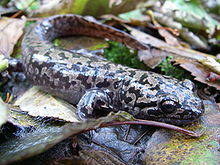Dicamptodon tenebrosus
| Coastal giant salamander | |
|---|---|
 |
|
| Scientific classification | |
| Kingdom: | Animalia |
| Phylum: | Chordata |
| Class: | Amphibia |
| Order: | Urodela |
| Family: | Ambystomatidae |
| Genus: | Dicamptodon |
| Species: | D. tenebrosus |
| Binomial name | |
|
Dicamptodon tenebrosus (Baird and Girard, 1852) |
|
| Synonyms | |
|
Amblystoma tenebrosum Baird and Girard, 1852 |
|
Amblystoma tenebrosum Baird and Girard, 1852
The coastal giant salamander (Dicamptodon tenebrosus) is a species of salamander in the Dicamptodontidae family (Pacific giant salamanders). It is endemic to the United States and Canada. There are three closely related species to this taxon: D. ensatus (California giant salamander), D. copei (Cope's giant salamander), and D. aterrimus (Idaho giant salamander).
The coastal giant salamander can reach up to 34 cm (13 inches) in total length. The coastal giant salamander has four toes on the front feet and five toes on the back feet. The species tail is around 40 percent of the total length of the salamander and is laterally compressed. The head, back, and sides have a marbled or reticulate pattern of dark blotches on a light brown or brassy-colored background. The head is broad with a shovel-like snout and a fold of skin across the throat called the gular fold. The eyes are medium in size and have a brass-flecked iris and a large black pupil. This species is one of the few salamanders capable of vocalizing.
Some coastal giant salamander larva continue to grow into an adult and become sexually mature without losing their external gills. This process is called neoteny. Neoteny is particularly common in the British Columbia populations. Adult-sized neotenes have a uniform brown coloring on their heads, sides, and backs.
The coastal giant salamander is endemic to the Pacific Northwest, found in Northern California, Oregon, Washington, and southern British Columbia.
Aquatic stages are found in clear, cool or cold, well-oxygenated streams, and sometimes also in mountain lakes and ponds. Metamorphosed adults occur in humid forests (under rocks and logs, etc.), near mountain streams, or rocky shores of mountain lakes.
...
Wikipedia

